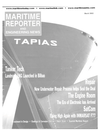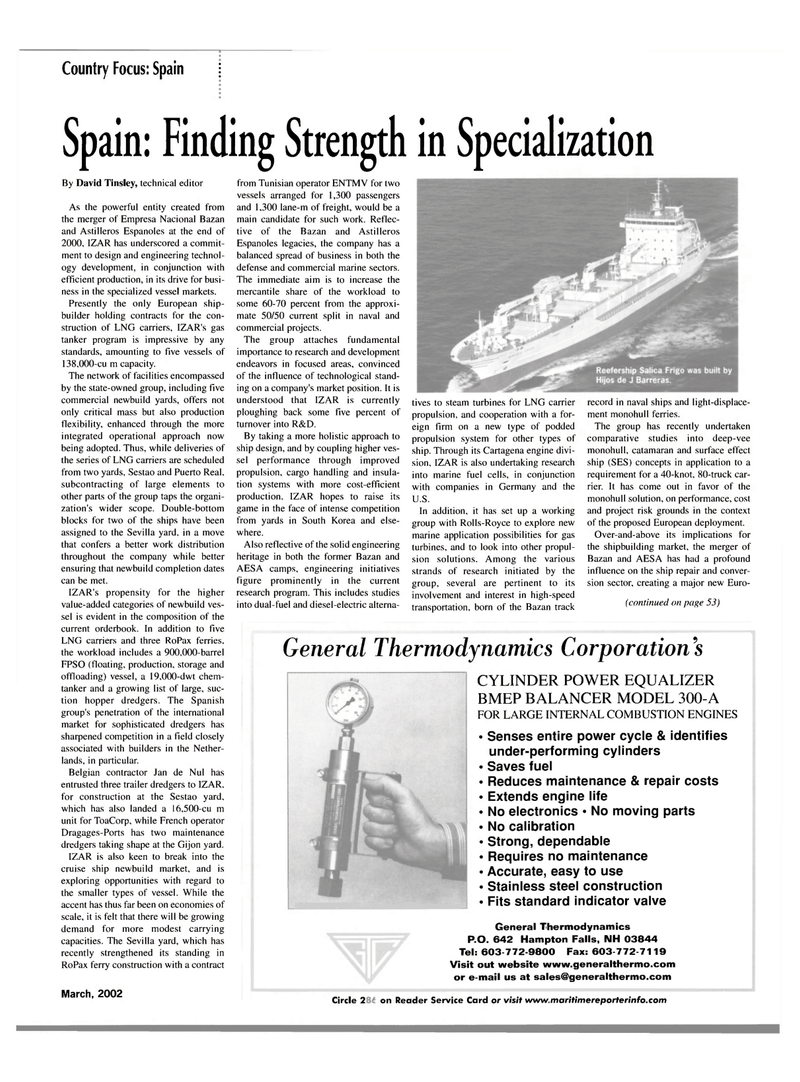
Page 51: of Maritime Reporter Magazine (March 2002)
Read this page in Pdf, Flash or Html5 edition of March 2002 Maritime Reporter Magazine
Country Focus: Spain j
Spain: Finding Strength in Specialization
By David Tinsley, technical editor
As the powerful entity created from the merger of Empresa Nacional Bazan and Astilleros Espanoles at the end of 2000, IZAR has underscored a commit- ment to design and engineering technol- ogy development, in conjunction with efficient production, in its drive for busi- ness in the specialized vessel markets.
Presently the only European ship- builder holding contracts for the con- struction of LNG carriers, IZAR's gas tanker program is impressive by any standards, amounting to five vessels of 138,000-cu m capacity.
The network of facilities encompassed by the state-owned group, including five commercial newbuild yards, offers not only critical mass but also production flexibility, enhanced through the more integrated operational approach now being adopted. Thus, while deliveries of the series of LNG carriers are scheduled from two yards, Sestao and Puerto Real, subcontracting of large elements to other parts of the group taps the organi- zation's wider scope. Double-bottom blocks for two of the ships have been assigned to the Sevilla yard, in a move that confers a better work distribution throughout the company while better ensuring that newbuild completion dates can be met.
IZAR's propensity for the higher value-added categories of newbuild ves- sel is evident in the composition of the current orderbook. In addition to five
LNG carriers and three RoPax ferries, the workload includes a 900,000-barrel
FPSO (floating, production, storage and offloading) vessel, a 19,000-dwt chem- tanker and a growing list of large, suc- tion hopper dredgers. The Spanish group's penetration of the international market for sophisticated dredgers has sharpened competition in a field closely associated with builders in the Nether- lands, in particular.
Belgian contractor Jan de Nul has entrusted three trailer dredgers to IZAR. for construction at the Sestao yard, which has also landed a 16,500-cu m unit for ToaCorp, while French operator
Dragages-Ports has two maintenance dredgers taking shape at the Gijon yard.
IZAR is also keen to break into the cruise ship newbuild market, and is exploring opportunities with regard to the smaller types of vessel. While the accent has thus far been on economies of scale, it is felt that there will be growing demand for more modest carrying capacities. The Sevilla yard, which has recently strengthened its standing in
RoPax ferry construction with a contract
March, 2002 53 from Tunisian operator ENTMV for two vessels arranged for 1,300 passengers and 1,300 lane-m of freight, would be a main candidate for such work. Reflec- tive of the Bazan and Astilleros
Espanoles legacies, the company has a balanced spread of business in both the defense and commercial marine sectors.
The immediate aim is to increase the mercantile share of the workload to some 60-70 percent from the approxi- mate 50/50 current split in naval and commercial projects.
The group attaches fundamental importance to research and development endeavors in focused areas, convinced of the influence of technological stand- ing on a company's market position. It is understood that IZAR is currently ploughing back some five percent of turnover into R&D.
By taking a more holistic approach to ship design, and by coupling higher ves- sel performance through improved propulsion, cargo handling and insula- tion systems with more cost-efficient production. IZAR hopes to raise its game in the face of intense competition from yards in South Korea and else- where.
Also reflective of the solid engineering heritage in both the former Bazan and
AESA camps, engineering initiatives figure prominently in the current research program. This includes studies into dual-fuel and diesel-electric alterna- tives to steam turbines for LNG carrier propulsion, and cooperation with a for- eign firm on a new type of podded propulsion system for other types of ship. Through its Cartagena engine divi- sion, IZAR is also undertaking research into marine fuel cells, in conjunction with companies in Germany and the
U.S.
In addition, it has set up a working group with Rolls-Royce to explore new marine application possibilities for gas turbines, and to look into other propul- sion solutions. Among the various strands of research initiated by the group, several are pertinent to its involvement and interest in high-speed transportation, born of the Bazan track record in naval ships and light-displace- ment monohull ferries.
The group has recently undertaken comparative studies into deep-vee monohull, catamaran and surface effect ship (SES) concepts in application to a requirement for a 40-knot, 80-truck car- rier. It has come out in favor of the monohull solution, on performance, cost and project risk grounds in the context of the proposed European deployment.
Over-and-above its implications for the shipbuilding market, the merger of
Bazan and AESA has had a profound influence on the ship repair and conver- sion sector, creating a major new Euro- (continued on page 53)
General Thermodynamics Corporation's
CYLINDER POWER EQUALIZER
BMEP BALANCER MODEL 300-A
FOR LARGE INTERNAL COMBUSTION ENGINES • Senses entire power cycle & identifies under-performing cylinders • Saves fuel • Reduces maintenance & repair costs • Extends engine life • No electronics • No moving parts • No calibration • Strong, dependable • Requires no maintenance • Accurate, easy to use • Stainless steel construction • Fits standard indicator valve
General Thermodynamics
P.O. 642 Hampton Falls, NH 03844
Tel: 603-772-9800 Fax: 603-772-7119
Visit out website www.generalthermo.com or e-mail us at [email protected]
Circle 254 on Reader Service Card or visit www.maritimereporterinfo.com

 50
50

 52
52
